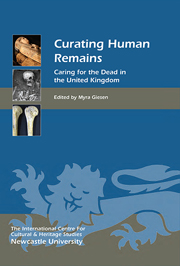Book contents
- Frontmatter
- Contents
- List of Illustrations
- Acknowledgments
- List of abbreviations
- Introduction: Human Remains Curation in the United Kingdom
- 1 International Perspectives towards Human Remains Curation
- 2 Dealings with the Dead: A Personal Consideration of the Ongoing Human Remains Debate
- 3 Care, Custody and Display of Human Remains: Legal and Ethical Obligations
- 4 The Impact and Effectiveness of the Human Tissue Act 2004 and the Guidance for the Care of Human Remains in Museums in England
- 5 Dead and Forgotten? Some Observations on Human Remains Documentation in the UK
- 6 Tethering Time and Tide? Human Remains Guidance and Legislation for Scottish Museums
- 7 The Quick and the Deid: A Scottish Perspective on Caring for Human Remains at the Perth Museum and Art Gallery
- 8 The Museum of London: An Overview of Policies and Practice
- 9 Curating Human Remains in a Regional Museum: Policy and Practice at the Great North Museum: Hancock
- 10 Curation of Human Remains at St Peter's Church, Barton-upon-Humber, England
- 11 Archaeological Human Remains and Laboratories: Attaining Acceptable Standards for Curating Skeletal Remains for Teaching and Research
- 12 ‘No Room at the Inn’ … Contract Archaeology and the Storage of Human Remains
- 13 Changes in Policy for Excavating Human Remains in England and Wales
- 14 Conclusions and Ways Forward
- Appendix 1 DCMS Guidance for the Care of Human Remains in Museums: Contents page and Part 2
- Appendix 2 MGS Guidelines for the Care of Human Remains in Scottish Museum Collections: Contents page and Chapter 2
- List of Contributors
- Index
- Miscellaneous Endmatter
9 - Curating Human Remains in a Regional Museum: Policy and Practice at the Great North Museum: Hancock
Published online by Cambridge University Press: 05 May 2013
- Frontmatter
- Contents
- List of Illustrations
- Acknowledgments
- List of abbreviations
- Introduction: Human Remains Curation in the United Kingdom
- 1 International Perspectives towards Human Remains Curation
- 2 Dealings with the Dead: A Personal Consideration of the Ongoing Human Remains Debate
- 3 Care, Custody and Display of Human Remains: Legal and Ethical Obligations
- 4 The Impact and Effectiveness of the Human Tissue Act 2004 and the Guidance for the Care of Human Remains in Museums in England
- 5 Dead and Forgotten? Some Observations on Human Remains Documentation in the UK
- 6 Tethering Time and Tide? Human Remains Guidance and Legislation for Scottish Museums
- 7 The Quick and the Deid: A Scottish Perspective on Caring for Human Remains at the Perth Museum and Art Gallery
- 8 The Museum of London: An Overview of Policies and Practice
- 9 Curating Human Remains in a Regional Museum: Policy and Practice at the Great North Museum: Hancock
- 10 Curation of Human Remains at St Peter's Church, Barton-upon-Humber, England
- 11 Archaeological Human Remains and Laboratories: Attaining Acceptable Standards for Curating Skeletal Remains for Teaching and Research
- 12 ‘No Room at the Inn’ … Contract Archaeology and the Storage of Human Remains
- 13 Changes in Policy for Excavating Human Remains in England and Wales
- 14 Conclusions and Ways Forward
- Appendix 1 DCMS Guidance for the Care of Human Remains in Museums: Contents page and Part 2
- Appendix 2 MGS Guidelines for the Care of Human Remains in Scottish Museum Collections: Contents page and Chapter 2
- List of Contributors
- Index
- Miscellaneous Endmatter
Summary
Introduction
The great north Museum: Hancock (GNM) is one of 12 museums, galleries and archives in the north East of England that collectively form Tyne & Wear Archives & Museums (TWAM). situated in the heart of Newcastle upon Tyne, the GNM incorporates collections from the original Hancock Museum, owned by the natural History society of Northumbria (NHSN) and opened originally in 1884, alongside collections from the former Newcastle university Museum of antiquities (owned by the society of antiquaries of Newcastle upon Tyne (SANT)) and the University's shefton Museum of Greek and Etruscan archaeology. The GNM is managed by TWAM on behalf of Newcastle University (the lead partner and main funder) in partnership with the above two societies and Newcastle City Council.
The GNM cannot be described as a ‘small’ museum, given the size of the building and the collections, but neither is it on the scale of any of the ‘national’ museums. In 2009, GNM was ranked 20th nationally in terms of the most visited free museums in the UK and was also the top visitor attraction in the North East of England in both 2009 and 2010, according to Visit England annual survey statistics (Visit England n.d.). The GNM operates under the ethos of the TWAM (1997) Mission statement: ‘to help people determine their place in the world and define their identities, so enhancing their self-respect and their respect for others’. This works alongside a longstanding commitment to service the needs of Newcastle University and the wider academic community by playing ‘a leading role in the economic, social and cultural development of the North East of England … providing access to museum facilities of the highest quality, and promoting engagement with the Museum through its exhibitions, collections, teaching, learning and research opportunities’.
- Type
- Chapter
- Information
- Curating Human RemainsCaring for the Dead in the United Kingdom, pp. 99 - 108Publisher: Boydell & BrewerPrint publication year: 2013

